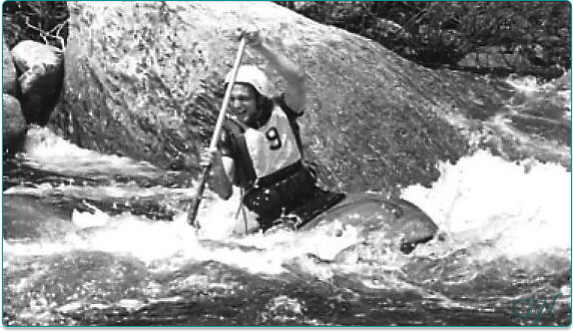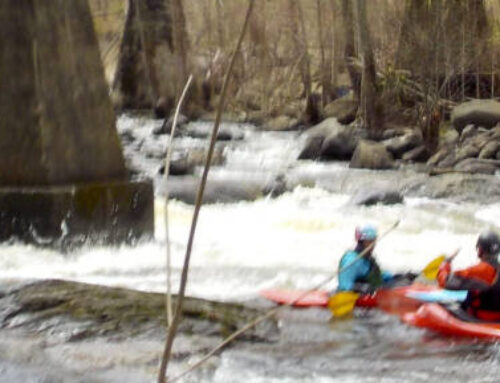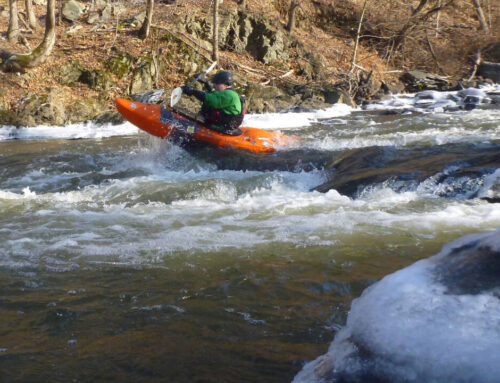Don’t be lulled into thinking that it’s only the crazy class 5 stuff that Wayne likes that can cause problems. I was out with 3 friends last March, and after having a good line through the one class 4 and no problems on the class 3 stuff I got to the last “rapid”. It was really just a short wave train that was fast, but really not even class 2. The very first wave was a small breaking wave, and as I hit it I got quickly displaced about 4 feet to the left, and probably pointed a bit left as well. That left me lined up to go through a couple of small branches from a small tree that was hanging out over the left bank, instead of skirting the end of it. That wasn’t a problem by itself, but it cheated me out of at least one good stroke, and that’s what I now needed to miss the pair of logs along the bank another 20 feet downstream.
Luckily, my instincts were good, and I leaned on to the top log as I broached on it, holding my upstream edge nice and high. The log was at about a 45º angle to the current, with the upstream end against the bank, and the bottom of the log just slightly in the water. The top of the bottom log was just a few inches below the top log, and that log pointed a bit more downstream, so the two logs made a bit of an X shape, with the center of the X at about the back of my cockpit. My boat was bouncing a bit in the current, but I felt pretty stable. While I waited for my friends to come help I first tried shimmying towards the downstream end of the log. I only need to go about 3 feet, but after moving a foot and looking at things I decided there was too much risk that the front of my boat might drop under the top log before I was far enough past it. That offered a chance of flushing past things, but several ways of being pinned and probably underwater, and maybe even trapped in the boat. For some reason that didn’t seem very appealing, so I shimmed back the other way. That took perhaps 30 seconds, which is when my first friend got there.
He started by wading out on the downstream side of the logs to grab hold of me, but it was too deep for him to get a good angle reaching over the top of the log. That was good news, because it mean that if I did go under the logs I’d probably go all the way under instead of being pinned against them or between the logs and the bottom. At that point the other two got there, and I told them to clip a rope to my stern grab loop and pull me backwards and just slightly upstream. What I should have told them was to clip to the safety bar behind the cockpit, on the right side. That would have helped to keep the boat rolled towards the log as they pulled, but by pulling from the grab loop the boat rolled upstream as they pulled back. I forget if that actually put my head in the water right away, but it seemed like a very good time to get out of the boat.
I pulled the skirt and got out, while keeping a very good grip on the rim of the cockpit, since the current now wanted to push me into or under the logs without the boat. I got my legs on the bottom log and one arm over the top log, then let go of the rim and got the other arm on the log and put one leg over the top log. I could feel a bit of a projection on the bottom log, but couldn’t quite get my foot on it, which would have made it easy to push up and climb over the top log. Instead I just held on a for a few seconds while my friend got downstream and gave me a better hand hold. That made it easy to climb up on the log and then off the end and onto the bank. Start to finish we figure it lasted about 2 minutes, and I’m pretty sure my friends were a lot more scared than I was. That’s because they couldn’t immediately tell that it was a pretty stable pin, and I was too busy thinking about solving the problem to be very worried.
So here are a few things to take away from the experience:
- I was following the fun wave train instead of the boring water towards the inside of the slight bend. I knew the sweeper was there, but I’m not sure I really saw the logs. Either way, it’s easy to be complacent when things aren’t especially difficult, but the rocks are just as hard and the current can be fast even in class 1 or 2.
- Always lean on to anything you’re about to broach on. If my upstream edge hadn’t been out of the water I would have been upside down, and somewhere under the top log almost immediately. As above, I might have just flushed completely under, but there are a number of ways I might have been stuck in a very bad place.
- Keep the group close together. If I’d been last in line I would have waited longer for help. There’s not much you can do about that, but I was close enough to have hollered for help if I had been last. With somebody close behind me I only waited while he got out downstream of the logs and came back up to me. With more separation it’s easy to miss a problem with the last paddler, and in almost all situations it will increase response time. In this case my friend was just behind me (and following the same line until he saw me get shifted left).
- Be very mindful of what will happen when you start doing things. There’s a potentially huge difference between acting quickly and acting hastily. You may need to hurry when things go wrong, but taking 10 or 15 seconds to think things through may be much better than starting a little bit sooner. Here are a couple of related things from my cave rescue classes: STOP! – Stop, Think, Observe, Plan. “Don’t just do something, stand there”.
- Be prepared. Carry a throw rope and other safety gear and know how to use it. Take a swiftwater rescue class, or at the very least, read a book or two. “Whitewater Rescue Manual” by Walbridge and Sundmacher is a good one, as is “River Rescue” by Les Bechdel and Slim Ray.










